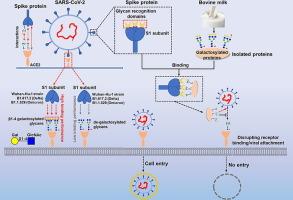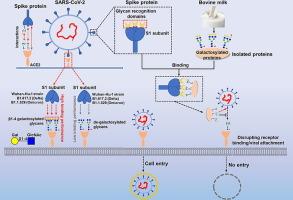牛乳半乳糖糖蛋白中SARS-CoV-2的关键β1-4 -半乳糖糖化受体及其抑制剂
IF 13
1区 综合性期刊
Q1 MULTIDISCIPLINARY SCIENCES
引用次数: 0
摘要
SARS-CoV-2的刺突(S)蛋白与血管紧张素转换酶2 (ACE2)的结合是感染过程中的关键阶段。虽然先前的研究表明S蛋白和ACE2被广泛糖基化,但聚糖在它们相互作用中的功能仍然不确定。目的研究SARS-CoV-2的糖蛋白受体,评价牛乳半乳糖糖蛋白对SARS-CoV-2假病毒附着的抑制作用。方法采用抗体覆盖凝集素芯片对SARS-CoV-2和ACE2的S蛋白s1进行糖谱分析。采用分子动力学模拟方法模拟S蛋白与ACE2的相互作用。利用分子对接模拟和蛋白质微阵列技术评估n -聚糖和β1-4 -半乳糖基化对SARS-CoV-2及其变异(B1.617.2 (Delta)和B1.1.529 (Omicron))与ACE2相互作用的影响。利用蛋白质微阵列和基于假病毒的微中和试验评估了从牛奶中提取的糖蛋白(特别是唾液化糖蛋白或去唾液化糖蛋白)对S1和ACE2相互作用以及假病毒附着和进入的影响。结果S1和ACE2均以半乳糖基化糖型为主。重要的是,我们证明了ACE2的β1-4半乳糖化n -聚糖在SARS-CoV-2 S1及其变异与ACE2的结合中发挥了至关重要的作用。从牛奶中提取的糖蛋白含有大量的半乳糖基化聚糖,这与ACE2的糖型相当。糖蛋白通过竞争性阻断S1与ACE2的结合,有效阻断了SARS-CoV-2假病毒的附着和进入。结论ACE2的β1-4半乳糖化n -聚糖作为糖受体在SARS-CoV-2的S1结合及其变异中发挥了重要作用。此外,具有“受体样”糖型的糖蛋白可能是预防SARS-CoV-2感染的有效抑制剂。本文章由计算机程序翻译,如有差异,请以英文原文为准。


Key β1-4 galactosylated glycan receptors of SARS-CoV-2 and its inhibitor from the galactosylated glycoproteins of bovine milk
Introduction
The binding of the spike (S) protein of SARS-CoV-2 to angiotensin-converting enzyme 2 (ACE2) is a critical stage in the process of infection. While previous studies indicated that the S protein and ACE2 are extensively glycosylated, the functions of glycans in their interactions remain uncertain.
Objectives
This study aimed to investigate the glycan receptors of SARS-CoV-2 and evaluate the inhibitory effects of galactosylated glycoproteins derived from bovine milk on the attachment of SARS-CoV-2 pseudovirus.
Methods
An antibody-overlay lectin microarray was used to profile the glycopatterns of the S protein-S1 of SARS-CoV-2 and ACE2. Molecular dynamics simulation was used to mimic the interaction between the S protein and ACE2. The effects of N-glycans and β1-4 galactosylation on the interactions between SARS-CoV-2, its variations (B1.617.2 (Delta) and B1.1.529 (Omicron)), and ACE2 was assessed using molecular docking simulation and protein microarrays. The impact of glycoproteins (specifically sialylated glycoproteins or de-sialylated glycoproteins) derived from bovine milk on the interaction between S1 and ACE2, as well as on pseudoviral attachment and entry, was assessed using protein microarrays and pseudovirus-based microneutralization assays.
Results
Our findings indicated that the galactosylated glycoforms were the most prevalent for both S1 and ACE2. Importantly, we demonstrated that the β1-4 galactosylated N-glycans of ACE2 played a crucial role in the binding of S1 of SARS-CoV-2 and its variations to ACE2. The glycoproteins derived from bovine milk had a large amount of galactosylated glycans, which are comparable to the glycoforms of ACE2. The glycoproteins effectively blocked the attachment and entry of the SARS-CoV-2 pseudovirus by competitively blocking the binding of S1 to ACE2.
Conclusions
Our findings demonstrated that the β1-4 galactosylated N-glycans of ACE2 play a crucial role as glycan receptors for the binding of S1 of SARS-CoV-2 and its variations. Moreover, the glycoproteins with ’receptor-like’ glycoforms could be an effective inhibitor to prevent SARS-CoV-2 infection.
求助全文
通过发布文献求助,成功后即可免费获取论文全文。
去求助
来源期刊

Journal of Advanced Research
Multidisciplinary-Multidisciplinary
CiteScore
21.60
自引率
0.90%
发文量
280
审稿时长
12 weeks
期刊介绍:
Journal of Advanced Research (J. Adv. Res.) is an applied/natural sciences, peer-reviewed journal that focuses on interdisciplinary research. The journal aims to contribute to applied research and knowledge worldwide through the publication of original and high-quality research articles in the fields of Medicine, Pharmaceutical Sciences, Dentistry, Physical Therapy, Veterinary Medicine, and Basic and Biological Sciences.
The following abstracting and indexing services cover the Journal of Advanced Research: PubMed/Medline, Essential Science Indicators, Web of Science, Scopus, PubMed Central, PubMed, Science Citation Index Expanded, Directory of Open Access Journals (DOAJ), and INSPEC.
 求助内容:
求助内容: 应助结果提醒方式:
应助结果提醒方式:


